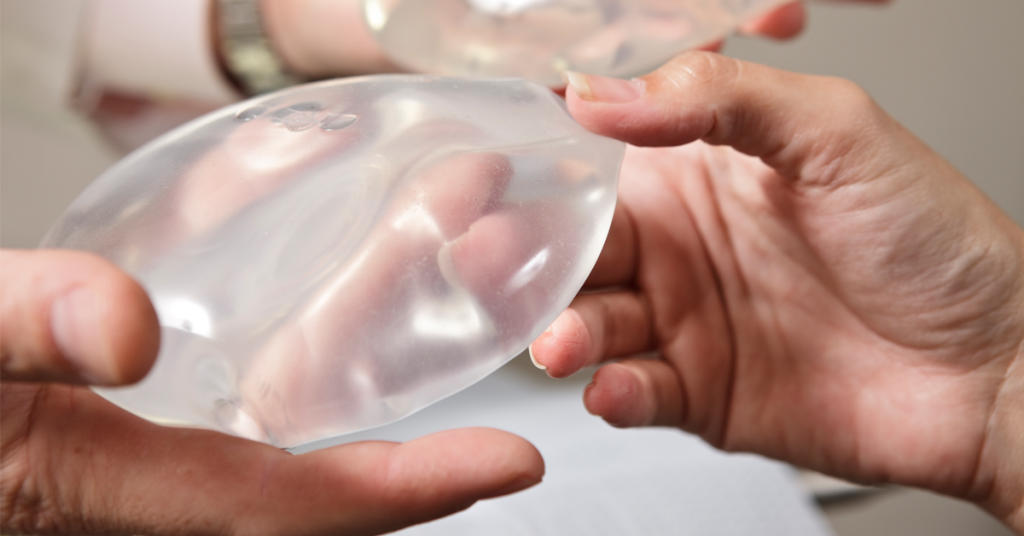Women who are researching breast implants soon realize that size is only one of the decisions involved in getting breast augmentation. As a plastic surgeon, I help patients navigate their choices during the consultation by explaining the differences between various concepts, such as size and profile.
That’s why I want to devote this blog post to explaining some of the jargon associated with breast implants in a way that I think is easily understood. Having a good grasp of the choices involved in breast enhancement enables patients to feel confident when making these decisions.
Size
What does “cc” mean? A cc is a cubic centimeter. Most patients use bra cup designations to describe their desired breast sizes — they want to go from a B cup to a D cup, for example. But anyone who tries on bras knows that cup sizes often vary significantly from one brand to the next. Using cc offers a standardized measurement for implants, regardless of the implant type or manufacturer.
The first photo shows a patient with 421cc implants, the second shows 375cc implants, and the final photo shows a patient with 330cc implants.
Shape
It may initially be a bit confusing to see implants referred to as round or shaped. Round is a shape, of course. Shaped implants are also sometimes called teardrop implants or anatomically shaped because they resemble the natural slope of a breast, with the lower two-thirds of the implant fuller than the upper third. Patients who want more cleavage and upper pole fullness are usually better off choosing round implants.
Material
With the development of newer implant technology, the choice of implant material is now expanded, with patients considering 3 main options: saline vs silicone vs gummy bear implants. The various consistencies of silicone implants provide patients with additional choices:
- Saline: Implants filled with a saltwater solution are less popular now because most patients believe they don’t look or feel as natural as silicone implants. The benefit of saline implants is that patients know immediately if they’re leaking because the implant deflates. The liquid solution is naturally absorbed by the body.
- Silicone: Traditional silicone gel implants are slightly softer than the new cohesive gel or highly cohesive gel implants. The gel has a thinner consistency, which some patients prefer to the form-stable cohesiveness of the newer generation of implants.
- Cohesive silicone gel: Sometimes called “gummy bear” implants, the cohesive silicone gel implants maintain their shape, even in the unlikely event of a rupture. Both types of silicone gel implants are best for women with little existing breast tissue because there is little risk of visible rippling or wrinkling, which can be a drawback with saline implants.
Profile
It’s safe to say this is the most difficult choice for patients to understand. Implants come in various profiles: low, moderate, moderate plus, and high are common, but there are others. An implant’s profile refers to how much it projects from the patient’s chest wall. But choosing the profile also involves considering the patient’s anatomy and the final result she wants. That’s why I take a 3-dimensional approach to recommending the size and projection of implants. In doing so, I can best match the implant profile with the patient’s body frame.
The first photo below shows a patient with low profile implants, and the second photo shows moderate plus implants.
Texture
The exterior of textured implants feels a bit like soft sandpaper with a pebbly surface. This helps them attach to the capsule in which the surgeon places the breast implant, limiting their movement. Smooth implants move more freely within the capsule. Typically, shaped implants are textured because it’s important that they don’t rotate at all within the capsule. If they do, it can give the breasts an asymmetrical appearance. Smooth, round implants, on the other hand, can move around because there is no “up” or “down” to them.
This information can sometimes seem overwhelming, especially if you’re just getting started researching breast augmentation. That’s why I take the time during consultations to carefully and thoroughly explain these terms in ways my patients can easily understand. You can request a consultation using our online for or by calling us at (518) 328-3330.







The FDA released an article the other day about 457 patients getting blood cancer from breast implants. They mentioned something about textured silicone implants being a common factor. What information can you share with potential clients/patients about this? I’ve always wanted implants but now I’m nervous…